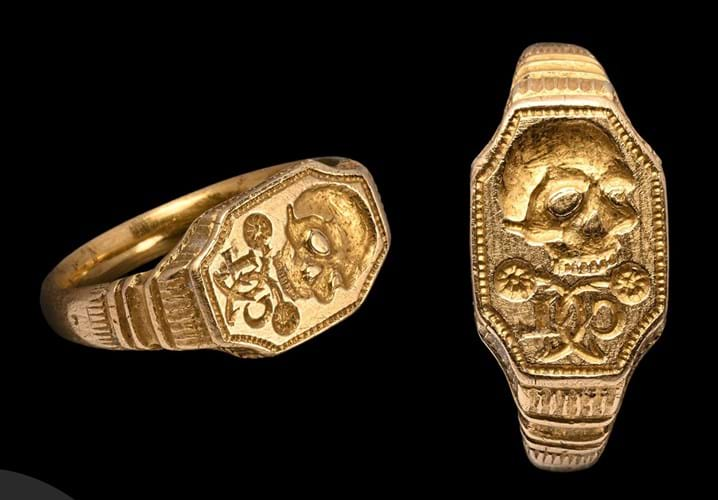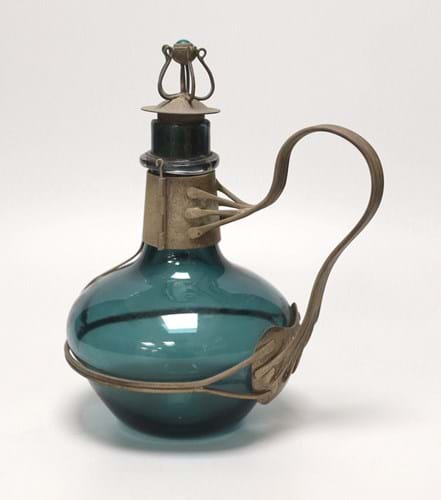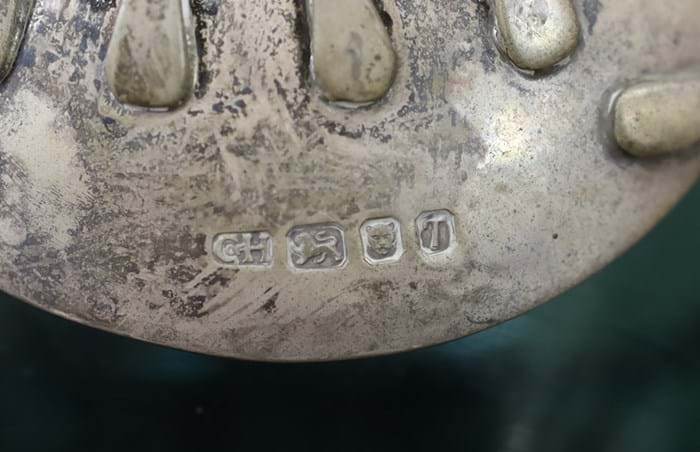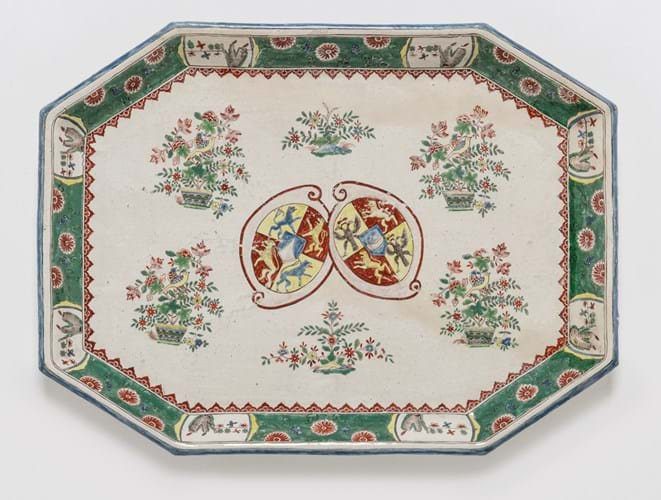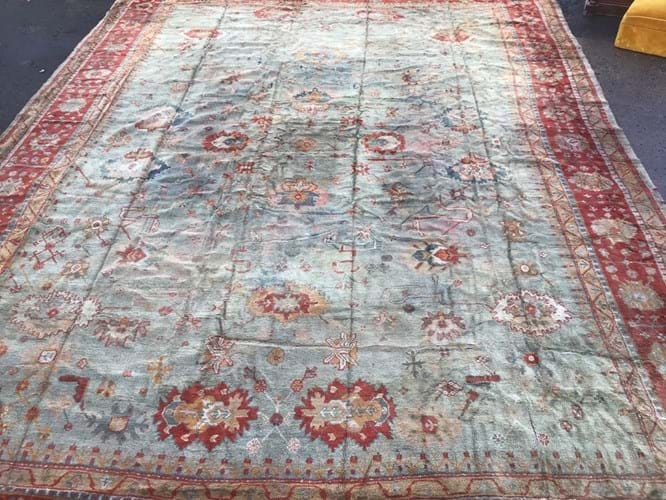1. Stuart period signet ring
For many years signet rings served a practical function as they could be pressed into hot wax to seal letters and act as a legal safeguard to witness wills, loans, commercial, personal and other documents.
Accordingly, they were often engraved with a coat of arms, initials, merchant's mark or some other personal symbol.
Several 17th century gold examples were offered by Timeline Auctions at Harwich, Essex on February 21 from the same London collection formed in the 1980s. This example is engraved to the bezel with a skull and two flowers separating the reversed initials CL.
The name of the original owner has been lost although his choice of subject matter gives us a clue to his thoughts. ‘Memento mori' or 'remember that you must die' imagery served as a reminder to Christians of the need to keep the soul in good order for the final judgment.
It was estimated at £5000-7000 but made £15,000.
A similar Stuart period ring from the same collection sold at £10,000 (estimate £3000-4000). The crest engraved to this example comprised an arm and hand holding a floral spray.
2. Guild of Handicraft claret jug – £2800
The quasi-medieval silver and glass ‘claret bottle’ designed by Charles Robert Ashbee for the Guild of Handicraft is one of the great moments of the arts and crafts movement.
Ashbee mentions it in his 1909 book Modern English Silver saying ‘The shape is taken from an Elizabethan sack-bottle found when digging the foundations of [my home] the Magpie and Stump in Chelsea.
Period examples dating from the first decade of the 20th century with the original Powell of Whitefriars glass still intact only very occasionally appear for sale, so it required a double or even a triple take when this lot appeared for sale at Gorringes in Lewes on February 20 with an estimate of just £50-80.
At first glance the wirework appeared sufficiently tarnished to be a century or more old but close inspection revealed the hallmarks to date from 1993, making this one of the later reproductions made by Hart Silversmiths in Chipping Campden.
When the Guild of Handicraft went into liquidation in 1908, the business was continued by George Henry Hart and still operates today, run by his great grandson.
A five-figure price was hence not on the cards but it nonetheless sold way above its guide at £2800.
3. Inkwell carved from ship timbers – £2500
La Lutine, launched by the French in 1779 and later requisitioned into the Royal Navy, is today best known for its sinking. When the 5th-rate ship of 38 guns was wrecked on a bank near Vlieland, Holland in 1799 she had a vast fortune in gold and silver aboard.
The majority of the cargo was never recovered from the shifting sands and Lloyds’s of London paid out in full.
She became something of an emblem for the insurance market. A representation of La Lutine was incorporated into the Lloyd’s crest and the ship’s bell brought to the London headquarters and struck when news of an overdue ship arrived.
During one of several salvage mission conducted for the underwriters, in 1859 La Lutine’s oak rudder was salvaged. The majority of the timber was used to make a boardroom desk and chair plus a series of trinkets – such as this 13in (33cm) diameter Victorian standish (or inkwell) carved with dolphin supporters, the arms for the City of London and the inscription 'La Lutine 1799’. It was offered by Lay’s in Penzance on February 16.
A number of these are known. One offered by Charles Miller in 2008 with a silver plaque stating it had been made from the ship’s rudder sold at £2200 and it was a similar sum of money required to purchase the slightly larger example sold in Cornwall. Estimated at £150-200, it took £2500.
4. 18th century faience tray – £14,000
The town of Ansbach, Mittelfranken became famous as a centre of faience manufacture in the 18th century. The so-called 'Ansbach Grüne Famille' made in imitation of Kangxi famille verte and Japanese kakiemon were its most celebrated wares with the decorator Johann Kaspar Rib (1681-1726), who also worked at factories in Nuremberg, Bayreuth, Braunschweig and Zerbst, being a key figure in its early history.
This 22in (55cm) octagonal rectangular tray, offered at the Fine & Decorative sale at Roseberys London on February 21, was made at Ansbach c.1730. Painted in the Kakiemon taste with a green border reserved with mons and vignettes of birds in flowering shrubs, it is centred by two large armorials.
It was not in good condition. In addition to some surface wear, a large crescent-shaped section of the rim has been broken and re-stuck with further areas of restoration disguising hairline cracks. However, as a very rare survivor from this prime period of the factory it sold at £14,000 (estimate £1000-1500).
The tray was among the highlights of the Robert Vater collection of European ceramics, a wide-ranging academic collection put together during the 20th century. Including representative examples from many of the key factories and pottery-making centres from the Renaissance to the early 19th century, elements of the collection were offered at Christie’s in December 2021.
5. Ziegler carpet – £20,000
When in 1883, Ziegler and Company of Manchester established a carpet factory in Sultanabad, it did so with a clear idea of its customer base.
The firm used the best artisans from the region and natural dying techniques but also hired designers from department stores such as Altman & Co of New York and Liberty in London, to modify Eastern designs for the more restrained western taste. In particular Ziegler carpets adopted a softer and lighter softer palette than their vibrant Persian counterparts. And what made them so desirable in the late 19th century is what makes them so coveted today.
A good example with an attractive and rare pale turquoise ground was offered by Railtons in Wooller, Northumberland on February 18. Described simply as ‘a massive country house Turkey carpet woven with floral motifs on pale green field framed by orange border with floral medallions’, it was in relatively good order and an excellent size at 24ft x 17ft 7in (7.32 x 5.36m).
It was estimated at £300-500 but sold to an online bidder via thesaleroom.com at £20,000.


